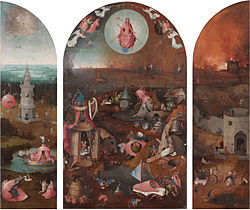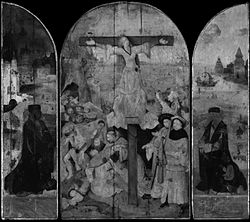| Image | Title | Year | Technique | Dimensions | Location | Details |
|---|
 | Adoration of the Magi | c. 1491–1498 | Oil on wood | 138 × 144 cm | Museo del Prado, Madrid, Spain | |
 | Saint Gregory's Mass | c. 1491–1498 | Oil on wood | 138 × 144 cm | Museo del Prado, Madrid, Spain | The outer panels of 'Adoration of the Magi' form a single image, Saint Gregory's Mass, rendered in grisaille. |
 | The Garden of Earthly Delights | c. 1495–1505 | Oil on wood | 220 × 389 cm | Museo del Prado, Madrid, Spain | |
 | The Creation of the World | c. 1495–1505 | Oil on wood | 220 × 389 cm | Museo del Prado, Madrid, Spain | The outer panels of the Garden of Earthly Delights form a single image, The Creation of the World, rendered in grisaille |
 | Hermit Saints Triptych | c. 1495–1505 | Oil on wood | 86 × 100 cm | Gallerie dell'Accademia, Venice | |
 | The Last Judgment | c. 1495–1505 | Oil on wood | 99.5 × 117.5 cm | Groeningemuseum, Bruges, Belgium | Attributed to Bosch and/or his workshop. The outer panels form a single image, Christ Crowned with Thorns. |
 | Outside panels of "The Last Judgment" | c. 1495–1505 | Oil on wood | 99.5 × 117.5 cm | Groeningemuseum, Bruges, Belgium | The outer panels form a single image, Christ Crowned with Thorns |
 | The Martyrdom of St. Julia | c. 1495–1505 | Oil on wood | 104 × 119 cm | Gallerie dell'Accademia, Venice, Italy | |
 | The Martyrdom of St. Julia | c. 1495–1505 | Oil on wood | 104 × 119 cm | Gallerie dell'Accademia, Venice, Italy | X-rays of The Martyrdom of St. Julia showing the painting originally depicted donors on the left and right |
 | The Temptation of St. Anthony (left, central and right panels) | c. 1500–1510 | Oil on wood | 131.5 × 225 cm | Museu Nacional de Arte Antiga, Lisbon, Portugal | |
 | The Temptation of St. Anthony (Reverse side of the outer panels) | c. 1500–1510 | Oil on wood | 131.5 × 225 cm | Museu Nacional de Arte Antiga, Lisbon, Portugal | The outer panels show two images: The Arrest of Christ and Christ Bearing the Cross, both rendered in grisaille. |
 | The Last Judgment | c. 1500–1505 | Oil on wood | 163.7 × 127 cm (central panel) 167.7 × 60 cm (left wing) 167 × 60 cm (right wing) | Academy of Fine Arts Vienna, Austria | The outer panels show two images: Saint James the Greater and Saint Bavo, both rendered in grisaille. |
 | Outside panels of The Last Judgment | c. 1500–1505 | Oil on wood | 167.7 × 60 cm (left wing) 167 × 60 cm (right wing) | Academy of Fine Arts, Vienna, Austria | The outer panels show two images: Saint James the Greater and Saint Bavo, both rendered in grisaille. |
 | The Haywain | 1510–1516 | Oil on wood | 147 × 232 cm (Escorial version) 135 x 190 cm (Prado version) | El Escorial, Spain (version 1) Museo del Prado, Madrid, Spain (version 2) | The outer panels form a single image, usually referred to as The Path of Life. |
 | Outside panels of "The Haywain Triptych" | 1510–1516 | Oil on wood | 135 x 190 cm (Prado version) | Museo del Prado, Madrid, Spain (version 2) | The outer panels form a single image, usually referred to as The Path of Life aka The Pedlar. |
 | Passion Triptych | c. 1530 | Oil on panel | 163 × 382 cm | Museu de Belles Arts de València, Valencia, Spain | Commissioned by Mencía de Mendoza (1508–1554) for her burial chapel (the Chapel of the Epiphany) in the convent of Santo Domingo, Valencia. Probably not a work by Bosch, but by a Flemish follower. -
|
|


























































